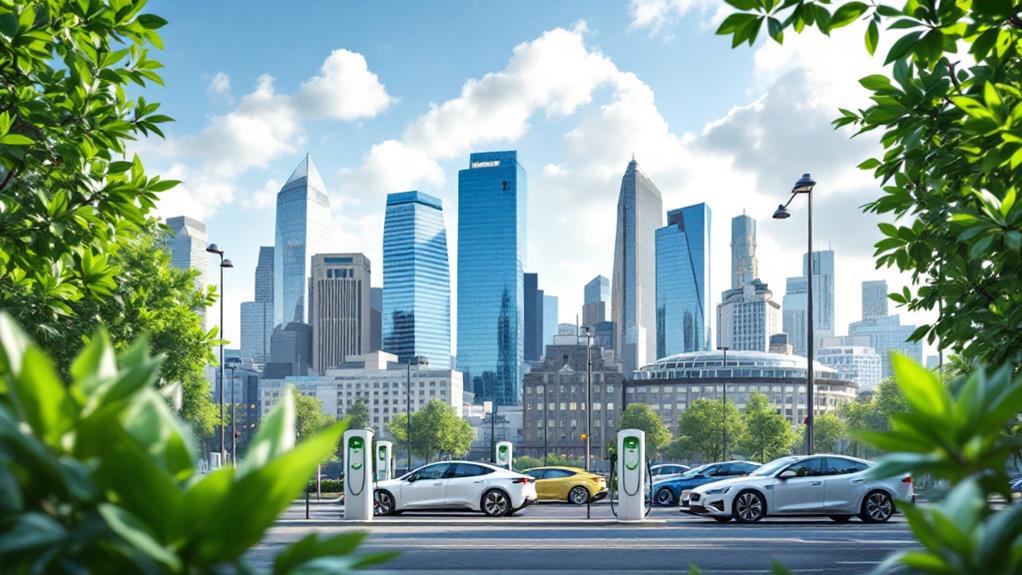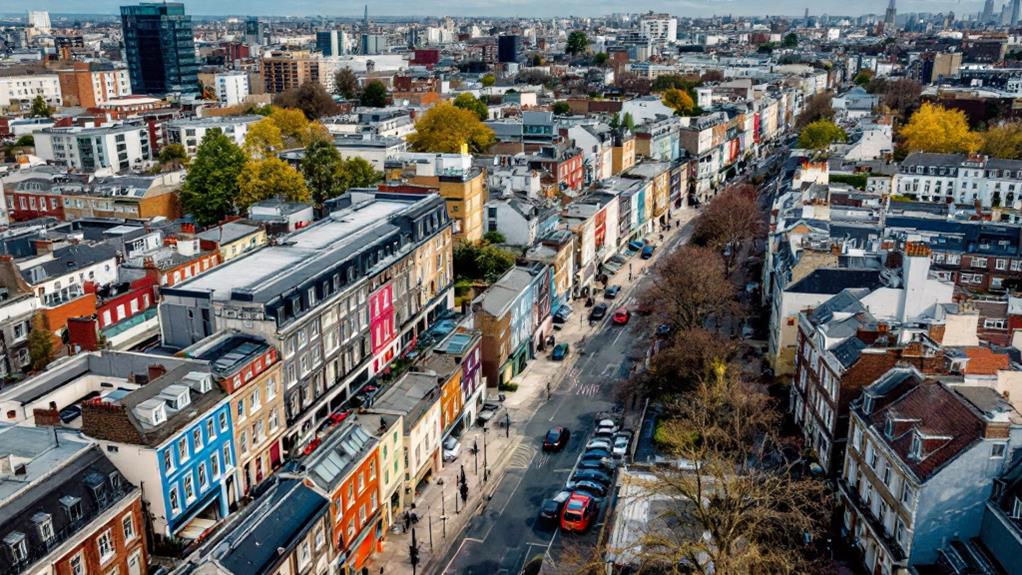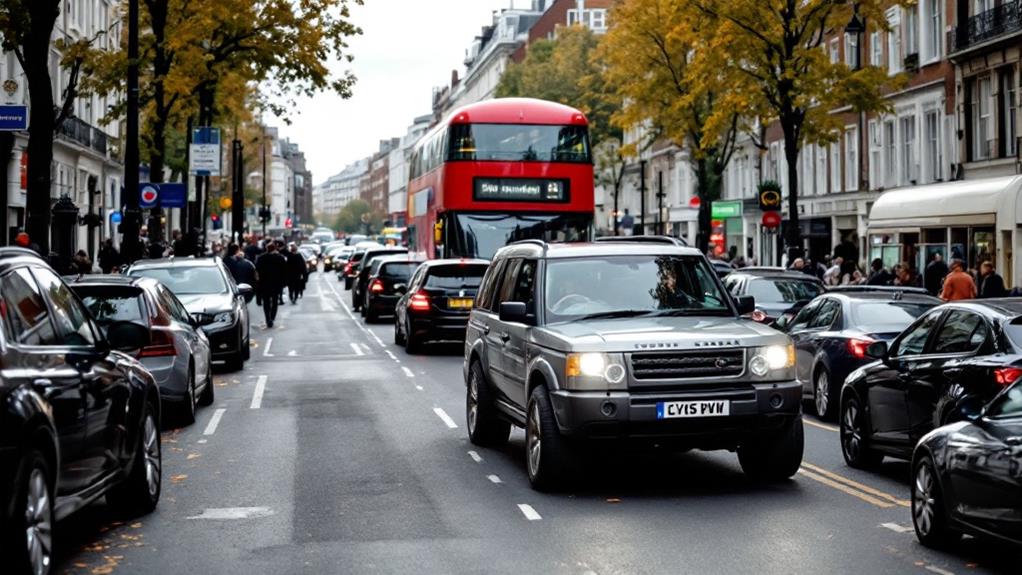How London's One-Way Streets Complicate Parking
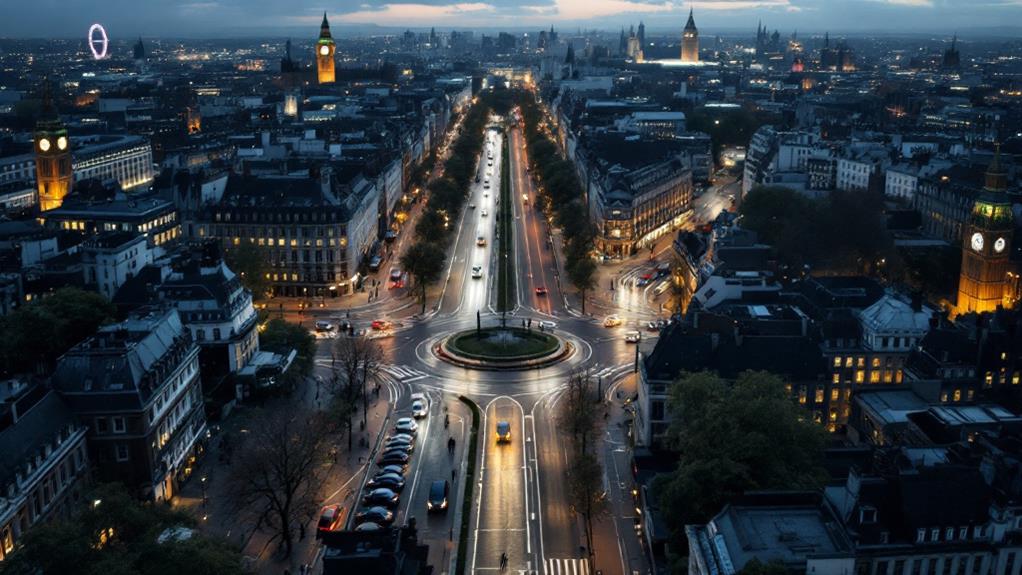
London's one-way streets considerably complicate parking by reducing on-street spaces by 20-30% compared to two-way streets. You'll face longer detours and increased search times, leading to more congestion and emissions. This system creates parking demand imbalances and heightens competition for available spots. As a driver, you'll experience increased frustration and stress, potentially leading to risky maneuvers. Parking enforcement faces challenges too, with obscured signage and difficulty observing both sides of the street. While technology solutions like smartphone apps and sensors are emerging, the one-way system continues to impact local businesses and the overall urban environment. There's much more to uncover about this complex issue.
Historical Context of One-Way Streets
The streets of London have undergone significant changes over the past century. You might be surprised to learn that one-way streets were first introduced in the late 19th century to improve traffic flow and reduce congestion. However, it wasn't until the 1960s and 1970s that you'd see a dramatic increase in their numbers, as city planners responded to the growing number of cars on the road.
While one-way streets were initially seen as a solution to traffic problems and a way to reduce accidents, they've had unintended consequences for parking. As these streets were implemented, you'd often find that on-street parking spaces were removed, forcing you to look for parking in nearby residential areas. This shift has led to the introduction of residential parking permit systems in many neighborhoods.
The complex network of one-way streets has made it increasingly challenging for you to find and access available parking spaces, especially in busy commercial areas. What was once a simple task of pulling up to your destination has become a complicated process of traversing through a maze of directional restrictions, often leading to frustration and wasted time.
Impact on Parking Availability
As you traverse London's intricate network of one-way streets, you'll quickly notice their significant impact on parking availability. These iconic urban arteries, while designed to improve traffic flow, have inadvertently reduced the number of parking spaces in the city. You'll find that one-way streets typically offer 20-30% fewer on-street parking spots compared to their two-way counterparts in central London.
When you're searching for a place to park, you'll encounter longer detours and increased search times due to the one-way system. This not only limits your options but also creates imbalances in parking demand. You might find some streets oversaturated while others have excess capacity, making London parking a challenging puzzle to solve.
If you're a resident relying on parking permits, you'll feel the pinch even more. The conversion of two-way streets to one-way has led to an average 15-20% reduction in total on-street parking spaces in affected areas. This means fewer spots for permit holders and increased competition for available spaces. As you maneuver London's one-way streets, be prepared for a potentially frustrating parking experience that requires patience and strategic planning.
Increased Congestion and Emissions
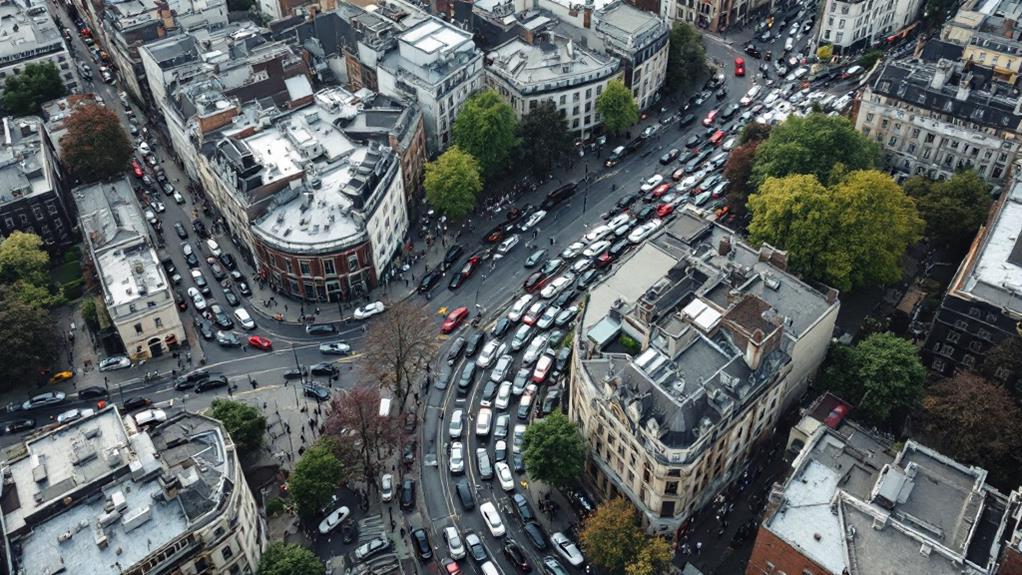
Traversing London's one-way streets can substantially increase your vehicle's emissions and contribute to the city's congestion woes. When you're forced to take circuitous routes, you'll likely experience longer trek times and higher fuel consumption. Studies show that one-way systems in London can increase your vehicle kilometers traveled by 20-30% compared to two-way streets, leading to higher levels of air pollution.
As you maneuver the High Street and surrounding areas, you'll find it more challenging to locate available parking spaces. This difficulty often results in extended periods of cruising and idling, further exacerbating congestion and emissions. The lack of direct routes may tempt you to seek shortcuts through residential neighborhoods, inadvertently increasing noise, pollution, and safety concerns for local residents.
The impact of one-way streets on London's environment is significant. Researchers estimate that the additional vehicle kilometers traveled and increased idling time contribute to an annual increase of over 10,000 tons of CO2 emissions. By understanding these effects, you can better appreciate the intricacies of London's traffic system and its broader environmental implications.
Driver Frustration and Behavior
Traversing London's one-way streets doesn't just impact the environment; it substantially affects driver behavior and emotions. You'll likely experience increased frustration as you're forced to take longer, circuitous routes to reach your destination. This can lead to heightened stress levels and potentially dangerous driving behaviors.
As you traverse these complex street networks, you might find yourself tempted to engage in risky maneuvers. Illegal turns or even driving the wrong way become more appealing when you're desperately searching for a parking spot. The disorientation and confusion you feel on one-way streets can trigger more aggressive or erratic behavior behind the wheel.
To combat these issues, consider exploring alternative routing methods, such as mobile apps specifically designed for one-way street systems. City planners should also focus on improved parking allocation strategies to reduce the time you spend circling for a spot. For driving stress mitigation, try to plan your route in advance and allow extra time for parking.
Challenges for Parking Enforcement
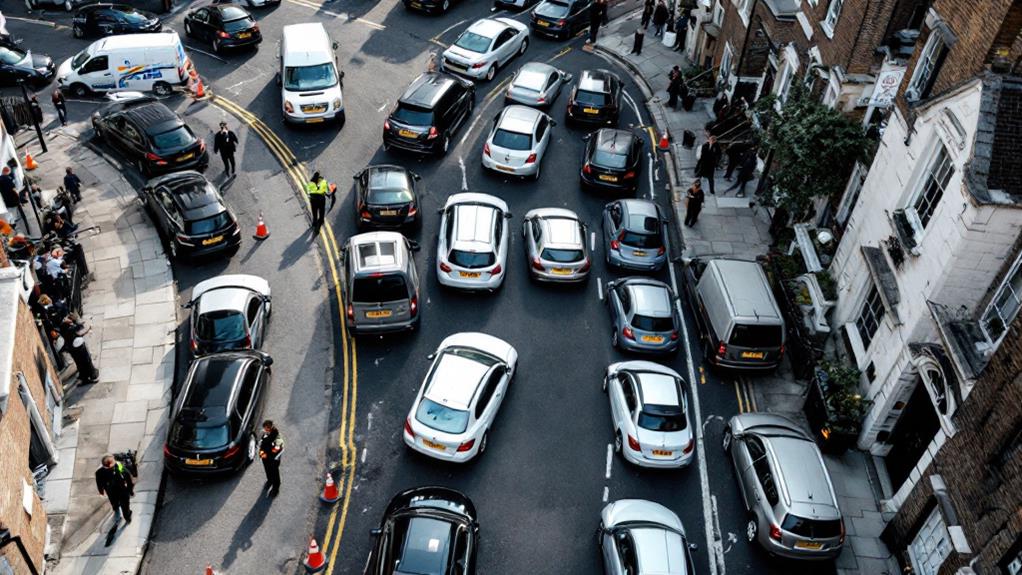
In light of London's intricate network of one-way streets, parking enforcement officers face significant obstacles. The unidirectional traffic flow makes it challenging to observe vehicles parked on both sides of the street, creating blind spots where illegally parked cars can hide. Obscured or difficult-to-see signage further complicates enforcement efforts, leaving officers struggling to determine parking restrictions accurately.
These challenges have led to the exploration of alternative enforcement methods and targeted enforcement strategies. Digital permit systems are being considered to streamline the process and improve accuracy. However, the unique layout of one-way streets continues to pose problems for traditional enforcement approaches.
The emotional toll on parking enforcement officers can be significant:
- Frustration at constantly missing violations due to limited visibility
- Anxiety over potential confrontations with drivers who claim ignorance of obscured signs
- Stress from the pressure to cover more ground in less time
- Demoralization when efforts to maintain order feel futile
To address these issues, London's parking authorities are now exploring innovative solutions that combine technology with strategic deployment of personnel, aiming to overcome the inherent challenges posed by the city's one-way street network.
One-Way Streets and Public Transport
While parking enforcement officers grapple with one-way street challenges, public transport faces its own set of obstacles. One-way streets in London significantly influence bus routes, creating routing inefficiencies that force buses to take longer, less direct paths to their destinations. This not only increases travel times but also makes bus schedules less reliable and harder to coordinate.
You'll notice that one-way streets limit the accessibility of bus stops, as buses may struggle to find convenient locations to pick up or drop off passengers. This can lead to a diminished passenger experience, with longer walks to reach stops and potentially missed connections.
Cyclists aren't immune to these issues either. One-way streets often create longer, more circuitous routes for bike riders, which can discourage cycling as a viable transportation option. Similarly, pedestrians face their own set of challenges, having to maneuver more complex crossings and take longer routes to reach their destinations.
These accessibility concerns and routing inefficiencies combine to create a less efficient and user-friendly public transport system in areas with numerous one-way streets. As a result, London's transportation planners must carefully consider the impact of one-way street designs on all modes of travel.
Technology Solutions for Parking Management
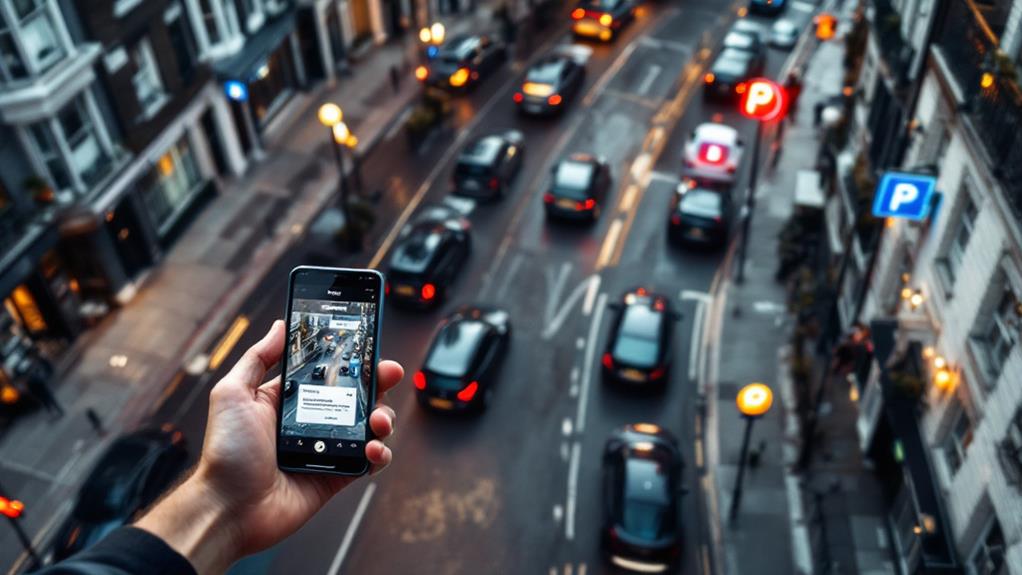
Numerous technological advancements have revolutionized parking management in London. Smartphone apps and sensors now provide real-time information on available parking spaces, reducing the time you spend circling for a spot. These integrated parking platforms combine data from various sources, including connected vehicle data, to offer a detailed view of parking options across the city.
Dynamic pricing systems adjust rates based on occupancy, helping to manage demand and optimize parking utilization. You'll find that mobile payment options have made it easier than ever to pay for parking, eliminating the need for cash or fumbling with parking meters.
Automated license plate recognition systems have streamlined permit management and enforcement, making the process more efficient for both drivers and authorities. Additionally, shared parking programs allow for better use of private parking assets during off-peak hours, giving you more options when searching for a spot.
Consider these emotional benefits of embracing parking technology in London:
- Less stress and frustration when finding parking
- Reduced environmental impact from decreased cruising
- Time savings for more important activities
- Improved overall urban mobility experience
Redesigning One-Way Systems
As London continues to transform its parking strategies, attention has turned to the city's network of one-way streets. You'll find that these one-way systems often limit parking availability by restricting access and traffic flow. However, converting them to two-way operations can increase parking capacity, allowing vehicles to park on both sides of the street.
When prioritizing parking needs, you must consider the intricacies involved in redesigning one-way systems. Integrating road designs for two-way traffic requires reconfiguring traffic signals, signage, and lane markings. This process can be challenging and may impact traffic flow in unexpected ways.
You should be aware that implementing two-way streets might require additional road width or the removal of some on-street parking to accommodate bidirectional traffic. Boroughs must carefully weigh the trade-offs between increased parking capacity and other street uses.
As you investigate options for redesigning one-way systems, remember that each street presents unique challenges. You'll need to assess the potential benefits of increased parking against the costs and disruptions of implementation. By carefully considering these factors, you can help shape more efficient and accessible parking solutions for London's evolving urban setting.
Economic Effects on Local Businesses
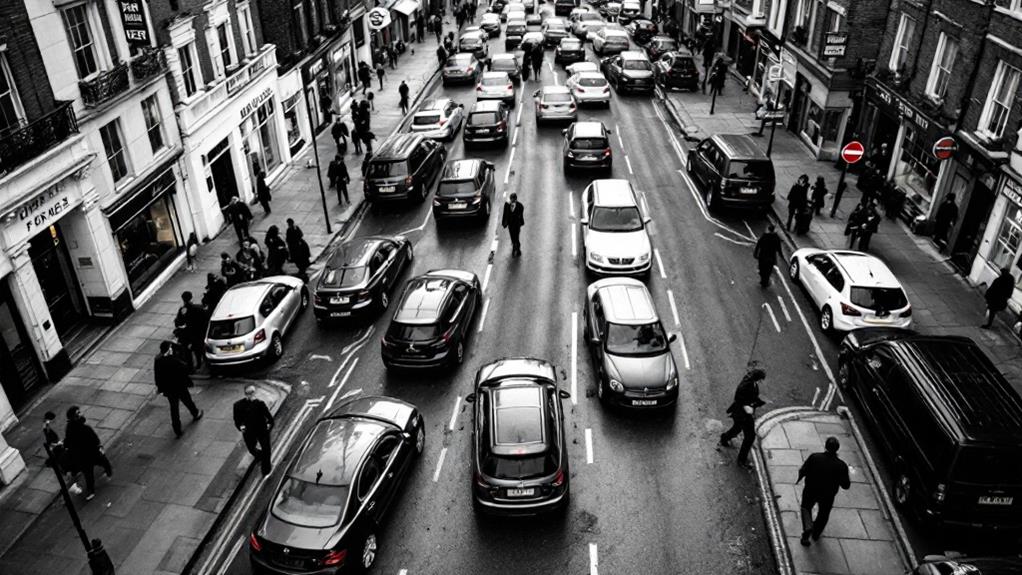
When considering the economic impact of one-way streets on local businesses, you'll find a significant correlation between traffic patterns and commercial success. One-way systems can pose substantial challenges for enterprises, affecting customer foot traffic patterns and local business accessibility. Studies have shown that these street configurations can lead to a staggering 20% reduction in retail sales compared to two-way streets.
The visibility challenges for enterprises on one-way streets are numerous, impacting their bottom line in various ways:
- Reduced customer access and visibility
- Decreased foot traffic and impulse purchases
- Limited parking availability and inconvenient loading zones
- Altered traffic patterns leading to less pedestrian activity
You'll notice that businesses along one-way streets often struggle with attracting and retaining customers. The lack of convenient parking and loading zones makes it harder for patrons to visit these establishments. Additionally, the indirect economic impacts of one-way systems can be far-reaching, affecting the overall liveliness of commercial areas. As drivers are less likely to stop on one-way streets, local shops and restaurants may see a decline in revenue from spontaneous purchases, further complicating their financial stability in an already competitive market.
Future of London's Street Layout
While London's street layout has long been characterized by one-way systems, the future may bring significant changes to improve parking accessibility and overall mobility. You'll likely see a shift towards converting some one-way streets to two-way operation, allowing for more flexible curb space allocation and easier parking access. This transformation could support broader mobility goals and create opportunities to prioritize non-driving modes.
As boroughs consider comprehensive parking reforms, they'll need to address the challenges posed by one-way streets. You might encounter new dynamic digital parking guidance systems integrated with the street network, helping you find available spaces more efficiently. These innovations could work alongside revised residential parking permit schemes to better manage limited kerb space.
The future may also bring a reevaluation of congestion pricing schemes in conjunction with street layout changes. By removing one-way restrictions on select streets, London could enable more flexible kerbside management and potentially reallocate space to pedestrians, cyclists, and public domain improvements. However, these changes will require careful planning to guarantee they benefit all road users and support the city's evolving mobility needs.
